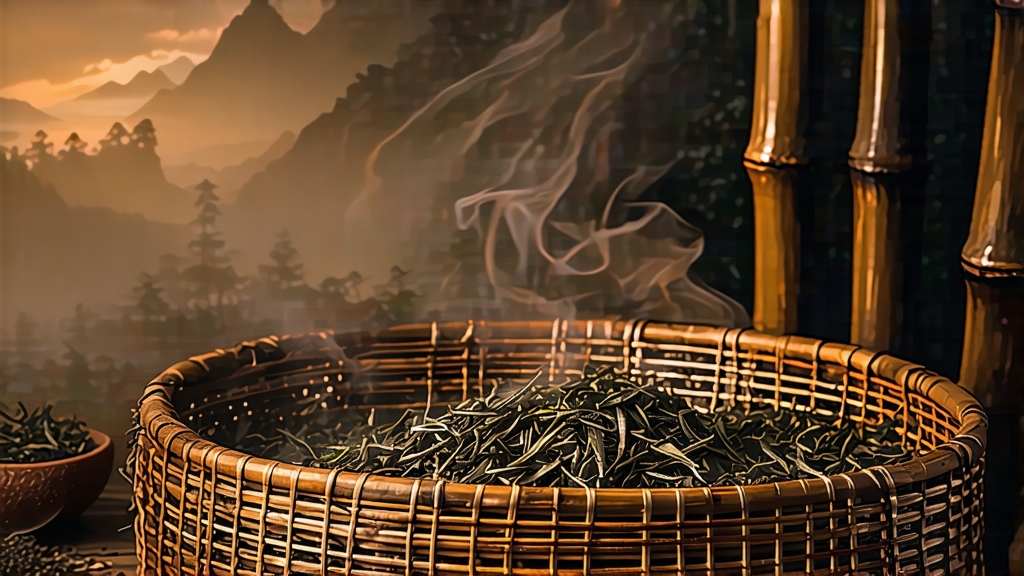
Ask most tea lovers to name a Chinese black tea and they will answer Keemun or perhaps Yunnan Gold; few realize that the very first black tea ever created was Lapsang Souchong, born in the cool, mineral-rich folds of the Wuyi Mountains of northern Fujian. Its Chinese name, Zheng Shan Xiao Zhong, literally means “fine-leaf variety from the original mountain,” a reminder that authenticity is tied to one narrow gorge—Tongmu Guan—where the story begins in the late Ming dynasty, around 1604. Local legend claims that passing Qing troops commandeered a tea factory one spring evening; fearful that the fresh leaves would spoil, the workers hastily dried them over the only available fuel—fresh pine logs—thereby unleashing an aroma so seductive that Dutch traders in Xiamen paid double the usual price. Whether myth or marketing genius, the technique survived four centuries and still defines the tea that would sail to Europe as “bohea,” become the cornerstone of English Breakfast blends, and inspire Carl Linnaeus to coin the term Thea bohea for the black-tea species.
Geography is the first secret. Tongmu Guan sits inside a national nature reserve cloaked in primordial humidity; morning fog drifts up the Jiuqu (Nine-Bend) River, wrapping tea gardens in a 85–90 % moisture blanket that slows photosynthesis and concentrates amino acids. The soil is a stony, slightly acidic laterite rich in quartz and manganese, forcing the semi-wild tea bushes—mostly a small-leaf cultivar known as Xiao Ye Zhong—to root deep, drawing minerals that translate into a cooling, pine-resin sweetness impossible to replicate elsewhere. Because the reserve bans outside leaf, genuine Zheng Shan is harvested only in the two weeks before Grain Rain, when shoots are still tight, downy and tinged purple.
The second secret is smoke, but not the blunt campfire note many imagine. In the traditional craft, fresh leaves are withered across second-floor bamboo racks suspended above a ground-level hearth of local Masson pine. The fire is kept low, never flaming, so the wood exudes resin-rich smoke that rises through slatted floors and drifts over the leaf for 8–10 hours. Crucially, the pine is stripped of bark to reduce harsh terpenes; the goal is a cool, aromatic smoke that perfumes rather than cooks. After this unique wither-oxidation fusion, leaves are rolled, fully oxidized for 90 minutes at 26 °C, then given a second, shorter smoking—called “refining fragrance”—before being baked over charcoal until only 3 % moisture remains. The result is a strip-shaped leaf, glossy black with hints of mahogany, releasing a dry aroma of pine honey, longan and dried lychee.
Yet Lapsang is not monolithic. Purists recognize three ascending grades. “Traditional Smoke” uses only reserve leaf and double pine firing; it is assertive, tarry, beloved by Russians who sip it from glass zarf. “New Craft” (or unsmoked) appeared in 2005 when local makers, responding to modern palates, omitted the final smoking, letting the natural Wuyi minerality speak through notes of stone fruit and cacao. Between these poles lies “Light Smoke,” leaf briefly kissed with pine at the refining stage, yielding a cup that marries sweet malt with a whisper of resin—an ideal gateway for novices. Finally, the micro-lot “Ji Pin (Supreme)” is crafted solely from buds plucked at dawn, smoked for only twenty minutes, then rested six months so the pine integrates into a silky, almost incense-like finish reminiscent of sandalwood and saffron.
To brew Lapsang Souchong gongfu style is to conduct a miniature symphony. Begin with soft water brought to 95 °C; hard water dulls the pine and exaggerates tannin. Pre-warm a thin-walled porcelain gaiwan (120 ml) to cradle aroma. Use 5 g of leaf—about two heaping teaspoons—rinsed for three seconds to awaken the oils. The first infusion, 8 seconds, releases a liqueur the color of late-autumn sherry and a nose that moves from campfire to candied orange peel. Second infusion, 12 seconds, deepens into notes of dark honey and roasted sweet potato. By the